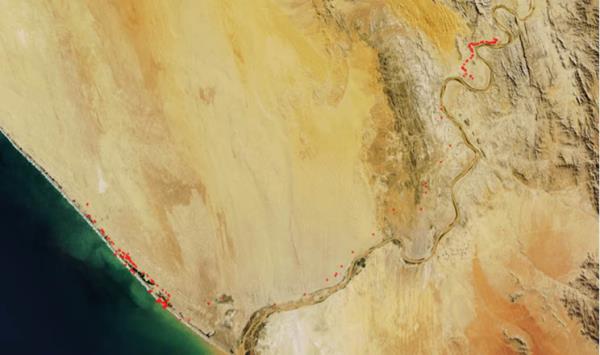03 April 2025

Data mapping showing the remote operating geography of the customer mine and location of drowsiness warning events (red dots) transmitted from Optalert systems via radio network
Mining is inherently dangerous, with workers facing constant risk from cave-ins, explosions, and exposure to toxic materials. One of the critical challenges in many mines, particularly in remote areas of Africa, is the lack of reliable connectivity, without which workers are left vulnerable. Indeed, modern mines increasingly require robust critical communications systems to ensure worker safety, enabling real-time alerts, monitoring, and coordination in emergency situations.
One major mining company operating in Namibia approached Optalert to discuss trialling the Eagle Industrial early-warning drowsiness detection system, which detects the physiological warning signs of early onset drowsiness. A tiny LED is built into the lightweight frame of the glasses and measures the velocity of the user’s eyelid 500 times a second. From this measurement the level of user fatigue can be derived in real time using the Johns Drowsiness Score (JDS).
The mine site in question was close to the ocean and covered a large area – some points were 40km from the centre of operations, and the only Wi-Fi available was in the town built for the mine with a very low range. Accordingly, the request to trial the Eagle came with a unique requirement – transmission of data via radio – leading Optalert to question how they could transmit data on a remote mine site without Wi-Fi or cellular coverage.
Modifying the components
Optalert systems already produce a low-bandwidth data stream enabling them to transfer data in near real-time over cellular or Wi-Fi; but for the solution to work over radio, data transmission at even lower bandwidths was required.
“When we looked at the price of setting up a private network to cover the entire mine site, it was prohibitively high,” says Renato Lopez, VP Sales LatAm, Optalert. “The radio solution was not even a compromise on quality. It had a lower price tag with rock-solid reliability.”
Thus began a collaborative development project in conjunction with the mining customer and Getac, the manufacturer of the Eagle Industrial tablet hardware. The objective was to ensure that the mine site in Southwest Africa had a robust, reliable data transmission platform.
This involved modifying the Eagle Industrial data transmission protocol to work over a Motorola two-way Tetra Radio system, requiring changes to the Optalert vehicle-based software and Android operating system to support the Point-to-Point Protocol (PPP) via an external RS232 serial port. This permitted a direct interface to the radio terminals with no additional hardware or changes to the cloud-based infrastructure. No change to the Eagle Industrial data files was required, and the customer’s network was configured to pass the data from the radio network to Optalert’s FRP server in the cloud.
This, ultimately, enabled site-wide data transfer from Optalert systems and allowed the mine operator to monitor its drivers via Optalert’s IRIS and view the data in Optalert’s FRP Reports.
From trial to success
The mining customer ran a three-month trial which enabled them to leverage their TETRA network via existing radio terminals in vehicles to enable drowsiness monitoring via Optalert’s IRIS.
By taking a collaborative approach, Optalert created a solution for a customer operating in a very remote location, which saved them from having to purchase and install expensive new network infrastructure. This enabled the mine operator to monitor their drivers via Optalert’s IRIS and receive daily and weekly reports based on the data transferred over the radio network. Given the low footprint of the system and the robustness of the radio network we installed, the mine operator had a rock solid, real-time view of all drivers’ drowsiness on-site.
“Although a very long-standing technology, wireless communications still have a lot of applications – especially in remote regions! They are low-cost, reliable and can transmit across very large distances,” notes Lopez.
Indeed, sites that are remotely located or greenfield often lack telecommunications infrastructure. However, they can transfer data via radio network and enable near real-time monitoring of the drowsiness levels of individual operators, as well as daily, weekly, and monthly reporting. This is a far lower-cost solution than building out a comprehensive network infrastructure.

The data journey – data from the Eagle Industrial is sent via radio to Optalert’s cloud server





.gif?lu=925)

